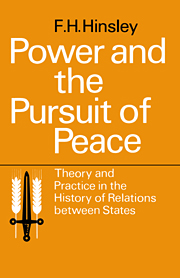Book contents
- Frontmatter
- Contents
- INTRODUCTION
- PART I A HISTORY OF INTERNATIONALIST THEORIES
- PART II A HISTORY OF THE MODERN STATES' SYSTEM TO 1900
- PART III INTERNATIONAL RELATIONS AND INTERNATIONAL ORGANIZATIONS IN THE TWENTIETH CENTURY
- 12 International Relations in the First Half of the Twentieth Century
- 13 The First World War
- 14 The Failure of the League of Nations
- 15 The Causes of the Second World War
- 16 The Nature and Development of the United Nations
- 17 International Relations since the Second World War
- References
- Index
12 - International Relations in the First Half of the Twentieth Century
Published online by Cambridge University Press: 11 January 2010
- Frontmatter
- Contents
- INTRODUCTION
- PART I A HISTORY OF INTERNATIONALIST THEORIES
- PART II A HISTORY OF THE MODERN STATES' SYSTEM TO 1900
- PART III INTERNATIONAL RELATIONS AND INTERNATIONAL ORGANIZATIONS IN THE TWENTIETH CENTURY
- 12 International Relations in the First Half of the Twentieth Century
- 13 The First World War
- 14 The Failure of the League of Nations
- 15 The Causes of the Second World War
- 16 The Nature and Development of the United Nations
- 17 International Relations since the Second World War
- References
- Index
Summary
If you ask people to characterise the politics of the first half of the twentieth century, and especially the international politics of the period, nine out often will reply that it had been an age of unparalleled violence. Many of them would add that the world is still faced with a crisis the like of which it has never previously experienced. Nor is it only laymen who take this view. The final volume of the new Cambridge Modern History, published in 1960, has The Age of Violence for its title.
In some ways this widespread belief is quite unfounded. The first half of the twentieth century was not the age of violence in the sense that every previous age had been a period of benevolence and peace. Recorded history is not an entirely unbroken saga of violence, but the historian knows that he must look much earlier than the twentieth century for the first examples of all the paraphernalia of violence with which the twentieth century has been familiar. International aggression, continuous, calculated, pathologically inspired? Thucydides is still the author of the best book on that subject; and there is no reason to be more disturbed by Hitler than by Louis XIV or Napoleon.
- Type
- Chapter
- Information
- Power and the Pursuit of Peace: Theory and Practice in the History of Relations Between States , pp. 275 - 288Publisher: Cambridge University PressPrint publication year: 1962



